In this blog post, we will take an in-depth look at the crunch exercise. We’ll start by answering the simple question, What is crunch exercise? After that, we’ll take a look at different types of crunch exercises and see how each exercise can help you achieve specific fitness goals. It’s like taking a friendly stroll through the world of exercise that strengthens your abs.
Table of Contents
What is Crunch Exercise?
Crunches are a type of abdominal exercise that primarily targets the muscles of the abdomen, particularly the rectus abdominis. To perform crunches, you typically lie on your back with your knees bent and your feet flat on the ground.
You then lift your upper body off the ground, contracting your abdominal muscles, and lower it back down. The motion is a short and controlled movement, focusing on flexing the spine.
Crunches are commonly included in fitness routines to strengthen the core and improve abdominal muscle definition. However, it’s important to note that solely relying on crunches may not be sufficient for overall core strength and health.
A well-rounded exercise routine that includes a variety of exercises targeting different parts of the core and other muscle groups is generally recommended.
How Many Types of Crunches Exercise
1. Basic Crunch

Basic crunch is a basic abdominal exercise. You lie on your back, bend your knees and use your abdominal muscles to lift your upper body. The idea is to bring your upper body off the ground while working your abdominal muscles. This is a simple but useful move that strengthens your midsection.
Remember to move slowly and with control. Whether you’re just starting out or you really love exercising, the basic crunch is a common exercise for your midsection. It helps strengthen your abdominals and makes your body more stable.
2. Reverse Crunch
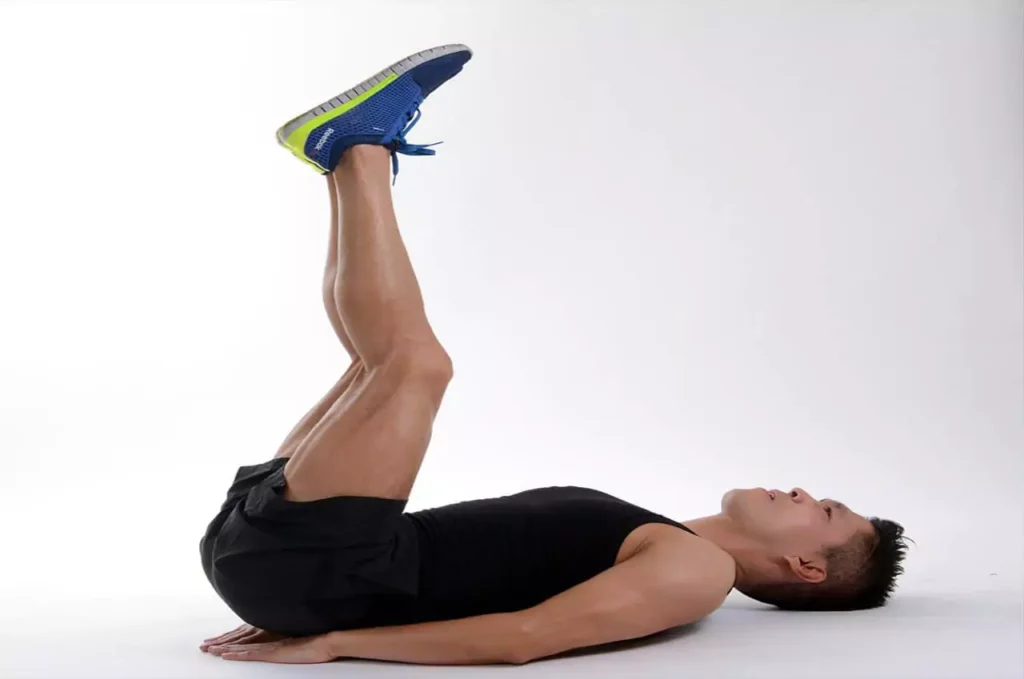
Reverse crunch is a different abdominal exercise. Lift your legs toward your chest while working your lower abdominals. This is not like regular abdominal exercises where you lift your upper body. It focuses on strengthening the lower abdominal muscles.
This is a simple but good exercise that adds variety to your workout. Whether you really like exercising or you’re just starting out, doing reverse crunches can help strengthen your entire abdominals. It makes your stomach more balanced and tight. So, this is a great exercise to include in your workout routine.
3. Oblique Crunch
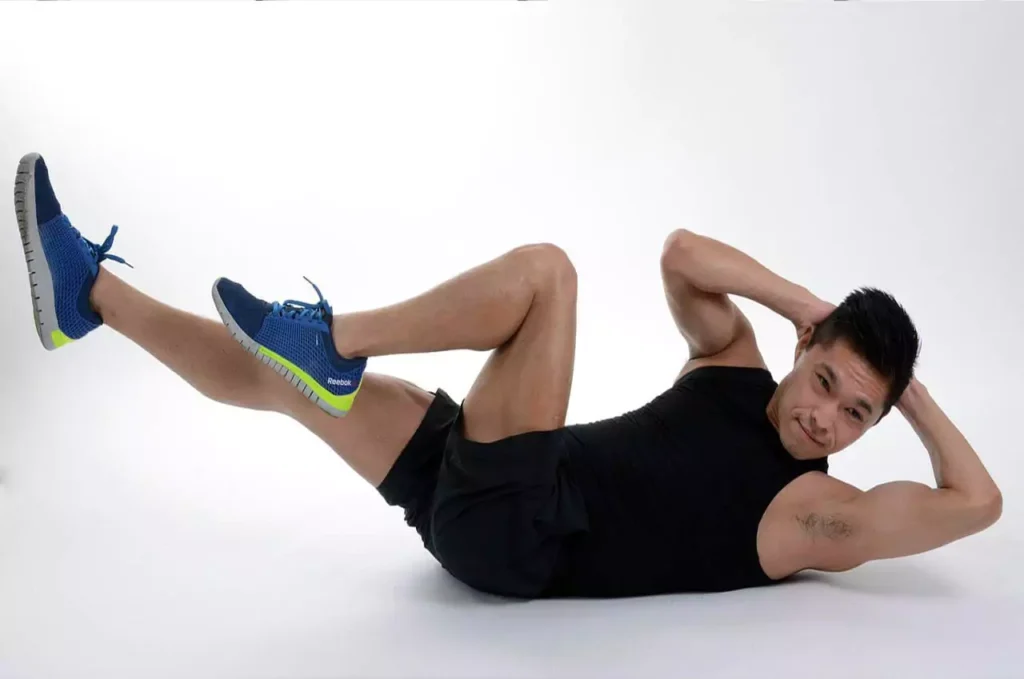
Oblique crunch is a special abdominal exercise for your lateral muscles. When you do this, you twist your body, each time bringing your elbow to the opposite knee. It helps work the sides of your abdominals, called obliques. Twisting activates these muscles, strengthening your lateral core.
Adding oblique crunches to your workout adds a twisting movement, making your abdominal workout more complete. It’s good for everyone, whether you love to exercise or are just starting out. Trying oblique crunches can improve your abdominal exercise and help you get a stronger and more balanced core.
4. Bicycle Crunch
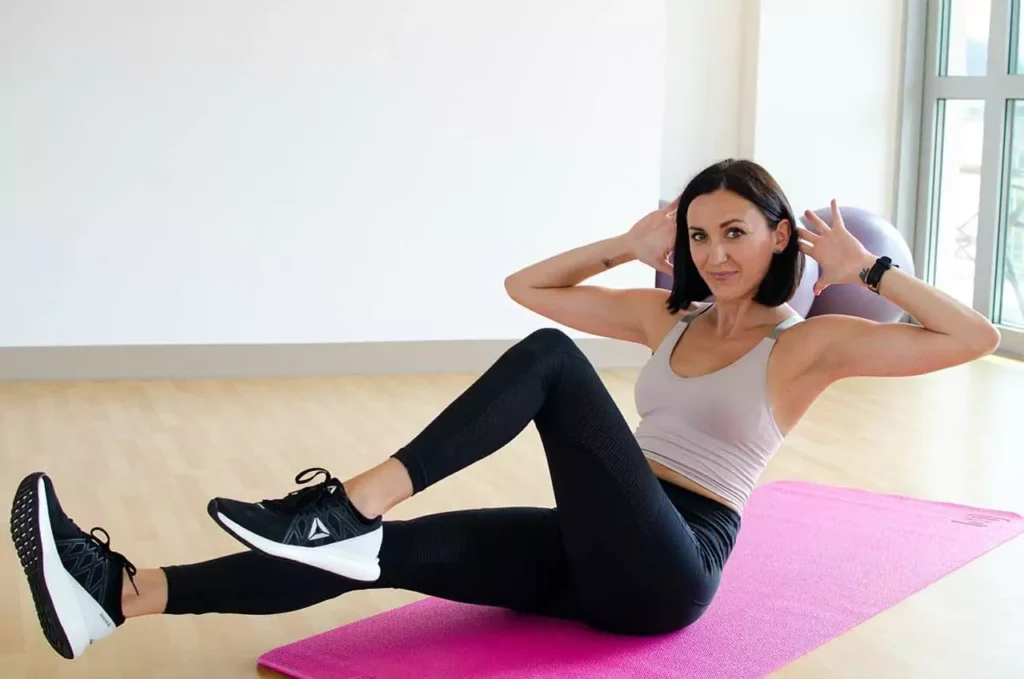
Bicycle crunches are an engaging abdominal exercise that is similar to pedaling a bike. Bend your elbows toward the opposite knee while extending your other leg, as if you were riding a bicycle. It is called a bicycle crunch because it resembles riding a bike. This exercise works multiple muscles, including the middle and sides of the abdomen.
When you twist your body and move your legs, it strengthens your abdominal muscles. Adding bicycle crunches to your exercise routine makes it more interesting and helps strengthen your abs. This is a good exercise for different fitness levels, so anyone can try it.
5. Vertical Leg Crunch
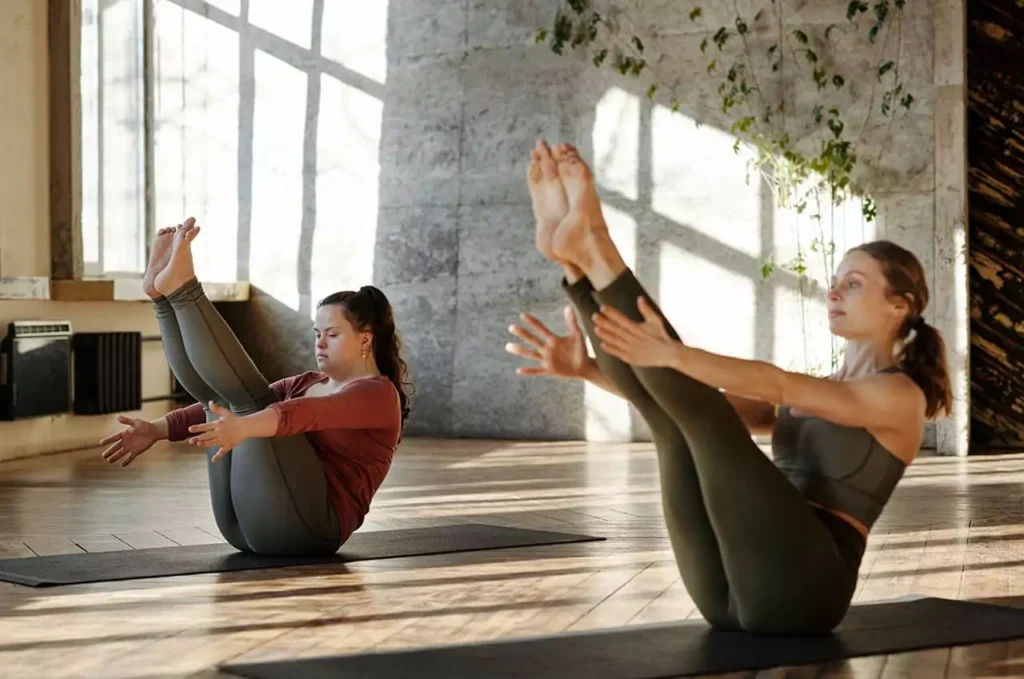
Vertical leg crunch is a targeted abdominal exercise that involves raising your legs straight up in the air while doing a crunch. To execute this movement, reach up to your toes, engaging both the lower and upper abdominal muscles. By raising your legs vertically, you intensify the challenge on your core.
This exercise emphasizes the entire length of the abdominal muscles, working both the lower and upper areas simultaneously. Incorporating vertical leg crunches into your workout routine is an effective way to increase core strength and definition. It provides a unique variation to traditional crunches and contributes to a more comprehensive abdominal workout.
6. Long Arm Crunch
The long arm crunch is a modified abdominal exercise that adds an extra challenge to your main workout. To perform this variation, extend your arms straight behind your head while performing a crunch. This action extends the lever arm, making the exercise more intense.
By lengthening your arms, you engage the abdominal muscles in a sweeping motion, which intensifies the contractions.
Long arm crunches are an effective way to target the rectus abdominis and increase overall core strength. Adding this variation to your routine adds variety to your abdominal exercises and contributes to a more intense and demanding workout.
7. V Crunch

The V crunch is a dynamic and effective abdominal exercise that involves lifting your upper body and legs simultaneously towards each other, forming a V shape with your body. This movement engages both the upper and lower abdominal muscles, creating a challenging but beneficial workout for the core.
By bringing your upper body and legs together in a V shape, you intensify the contraction in the abdominal area. The V crunch is an excellent exercise for targeting the rectus abdominis and increasing overall core strength. Adding this activity to your routine adds variety and contributes to a holistic approach to abdominal training.
8. Plank Crunch

The Plank Crunch is an active exercise that mixes the steadiness of holding a plank with the muscle work of a crunch. Start by getting into a plank position, making sure your body is in a strong, straight line from your head to your heels. While doing this, bring one knee at a time towards your chest, switching between each leg.
This move makes the workout more intense, especially for the lower part of your abdominal. The Plank Crunch not only makes your middle work hard but also makes your whole body stronger and more able to keep going. It’s a flexible exercise that works well for different fitness levels and gives a good workout for your abdominal when you’re doing a plank.
9. Side Plank Crunch
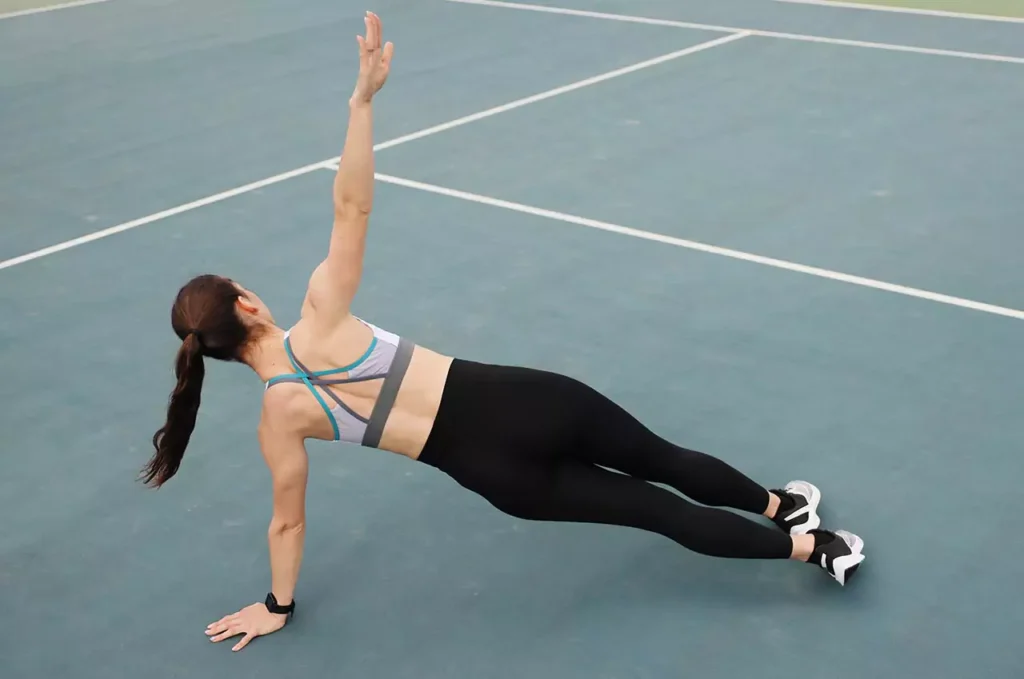
The side plank crunch is a targeted exercise that combines the strength-building benefits of the side plank with oblique engagement. To perform this movement, get into a side plank position, supporting your body with one hand and the side of your foot. Then, bring your upper elbow and knee toward each other in a crunching motion.
This activity specifically targets the oblique muscles on the side of your abdomen. Side plank crunch increases lateral core strength and stability, which contributes to a well-rounded abdominal workout. It’s a focused exercise that adds variety to your routine, promoting the development of a strong and flexible core.
10. Hanging Leg Raises

Hanging leg raises are a challenging abdominal exercise that involves hanging from a bar and lifting your legs straight toward the ceiling. In this movement, you target the lower abdominal muscles, which work to lift your legs against gravity. This exercise not only activates your lower core but also increases overall abdominal strength.
Hanging leg raises require upper body strength to hang from the bar and lower body control to lift the legs. Adding this exercise to your routine contributes to a comprehensive abdominal workout that focuses on the lower region and promotes both strength and stability in the core.
11. Decline Crunch
The Decline Crunch is a specific abdominal exercise using a decline bench. Sit on the bench, keeping your legs up and head down. Lie on your back, with arms crossed or behind your head. Lift your upper body towards your knees, using your belly muscles. Breathe out during the crunch, really feeling your upper belly squeeze.
Lower your upper body slowly, paying attention to the downward movement. This exercise makes your abdominal work hard, especially the upper part. Make sure you do it right and increase the difficulty as you get stronger, based on how fit you feel.
12. Swiss Ball Crunch
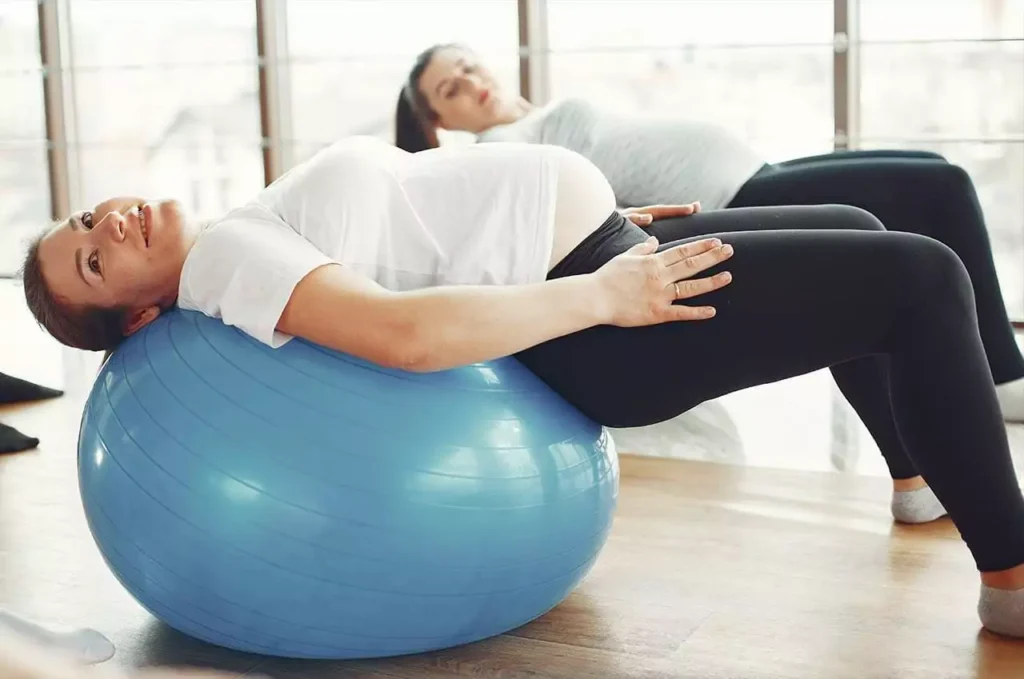
The Swiss Ball Crunch is a good abdominal exercise using a big ball. Start by sitting on the ball, making sure it’s steady and supports your lower back. Move your feet forward, so the ball rolls under until your lower back is on it.
Cross your arms on your chest or put your hands behind your head. Squeeze your abdominal muscles and lift your upper body up, reaching towards the ceiling. Feel your abdominal muscles tighten at the top. Lower down carefully, keeping steady on the ball. This exercise makes your middle strong, especially the front abdominal muscles. Pay attention to doing it right for a good workout.
13. Cable Crunch
Cable crunch is a specialized abdominal exercise using a machine with a cable. First, set the cable at a height, and attach a rope or bar to it. Kneel toward the machine, holding the rope or bar with both hands near your head. Keep your hips stable and start by bending your body from the waist, bringing your elbows down toward the floor.
Press your abdominal muscles very hard from below. Slowly return to the start while maintaining tension on your abdominals. This exercise works the muscles on the front and sides of your abdomen, strengthening your midsection. Do this slowly and carefully for best results, and don’t use really heavy weights.
Keep in mind, it is good to incorporate different exercises into your routine to work on all areas of your abdominals and make your body strong and stable. Make sure you do the exercises correctly. If you’re concerned or have health issues, talk to a fitness expert or your doctor. They can help you stay safe and healthy while exercising.
Read More : Top 5 Foods That Burn Stubborn Belly Fat
Top 5 Advantages of Crunch Exercises
- Crunches focus on your tummy muscles, making your core strong and well-shaped. This not only helps you stay balanced but also makes you stand up straighter over time.
- You can do crunches almost anywhere, without needing lots of room or special gear. They’re perfect for busy folks, fitting easily into your daily routine.
- Crunch exercises are flexible, so you can change them to match your fitness level or target specific parts of your core. This means your workout routine can adjust as you get better.
- Crunches are great for toning your tummy. They work your belly muscles, helping you lose extra fat and get a more sculpted look, especially around your midsection.
- Crunches are safer than some intense exercises. If you do them right, there’s less chance of getting hurt, making them a good choice for people with back problems or those who are just starting to get fit.
Top 5 Disadvantages of Crunch Exercises
- When doing crunches, be careful with your neck and lower back. Doing them wrong can make your neck and back uncomfortable and sometimes even lead to injury.
- Crunches mainly focus on your abs, leaving out other important core muscles. To build balanced strength and stability, try adding more exercises that work your entire core.
- Doing lots of crunches can make your hip flexors feel tight. This might cause discomfort and make your hips less flexible over time.
- Crunches involve bending your spine a lot. If you bend too much, it can stress your spine and cause lasting damage. Always keep good form to lower this risk.
- If you have certain health issues like back problems or hernias, doing crunches might not be the best choice. There are other exercises that could be better and safer for you.
Helpful & Important Tips for Crunch Exercises
- Belly Button To Spine: Engage your core, not momentum, like sucking your belly button towards your spine.
- Neck Neutral: Let your head follow your torso naturally, don’t pull with your hands.
- Slow and Controlled: Move with intention, focusing on the muscle squeeze, not speed.
- Quality over Quantity: Fewer perfect reps trump sloppy sets, listen to your body.
- Breathe Easy: Inhale on the way down, exhale on the crunch to maintain core tension.
- Mix it Up: Keep your core challenged with different crunch variations like bicycle or reverse crunches.
- Feel the Burn: Don’t just go through the motions, focus on the targeted muscle working.
- Progress Gradually: Start small and increase reps/sets as you get stronger.
- Listen to your Body: Stop if you feel pain, adjust form or take a break.
- Consistency is Key: Regular crunches, even a few a day, add up to a stronger core.
Conclusion
Crunch exercises are simple but powerful moves that can strengthen your core. Now that you know what a crunch exercise is and the different ways to do it, you’ve got useful tips to reach your fitness goals.
Remember, being consistent and paying attention to how you do it is your friend in this fitness journey. Whether you want toned abs or an overall stronger core, incorporate crunches into your routine to achieve your fitness goals.
We hope that we have managed to answer the question “What is crunch exercise and types of crunch exercise?” in this blog post. Do you enjoy reading blog posts then we are sure you will be a fan of our next blog post. Please share it with your friends and family also.
FAQ Frequently Asked Questions
Q1. What is the Best Crunch Exercise?
Ans:The best crunch exercise is the bicycle crunch, which incorporates both upper and lower body movements for extensive core engagement.
Q2. Do Crunches Burn Belly Fat?
Ans: Crunches alone cannot reduce belly fat to a great extent. A combination of healthy diet and overall exercise is more effective for fat loss.
Q3. How Many Crunches is Enough?
Ans: Beginners might start with just 10-15 crunches per set, while advanced exercisers could handle 25-30 or more.
Q4. Does Crunch Give You Abs?
Ans: No, crunches alone won’t give you abs, but they can contribute when combined with low body fat and diverse core exercises.
Q5. Do Crunches Slim Your Waist?
Ans: Crunches primarily target the abdominal muscles and can contribute to a more defined waist, but overall fat loss and a healthy diet play an important role in slimming the waist.